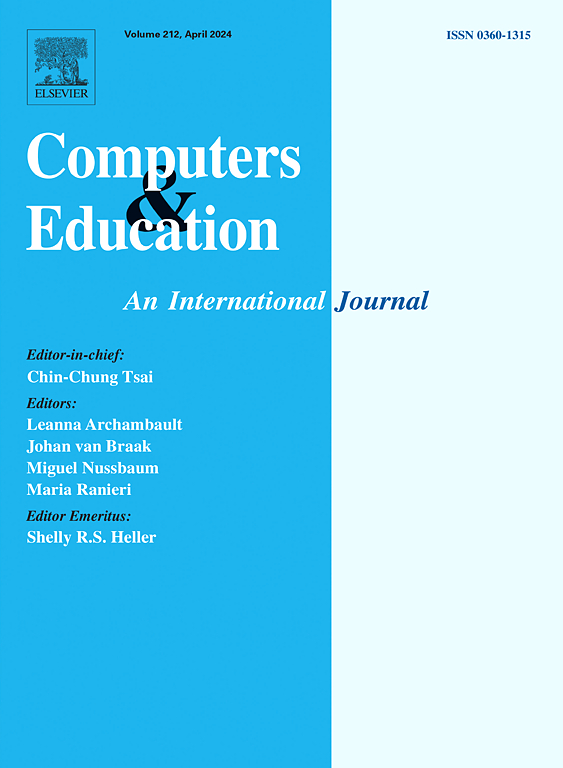Understanding college students’ cross-device learning behavior in the wild: Device ecologies, physical configurations, usage patterns, and attention issues
IF 10.5
1区 教育学
Q1 COMPUTER SCIENCE, INTERDISCIPLINARY APPLICATIONS
引用次数: 0
Abstract
The use of multiple devices to access educational materials is becoming more prevalent, offering benefits for both formal and informal learning. However, research on college students' cross-device learning patterns and the challenges remains limited. This study employed a two-week diary study method and follow-up interviews with 36 college students. Comprehensive data were collected from 374 cross-device learning activities, including text, voice recordings, and photos, offering valuable insights into participants' cross-device learning behaviors in terms of the device ecologies, physical configurations, usage patterns, and attention issues. Regarding device ecology, students typically used two to three types of education devices, with laptops and desktops serving as primary tools, and smartphones, tablets and smartwatches as secondary aids. Physically, devices were often arranged vertically and positioned in ways that required body or head movement. The students’ usage patterns revealed a preference of completing tasks simultaneously rather than sequentially. Five key workflow patterns were identified, from most to least prevalent: integrated, partition, migrated, expanded and cloned. Common combinations of these workflows included the integrated-partition, integrated-expanded, and integrated-migrated patterns. Instant messaging applications were the most frequently used method for information and data transfer. In terms of attention issues, most participants prioritized their attention allocation. Endogenous attention shifts occurred slightly more frequently than exogenous shifts, though exogenous shifts were more disruptive to learning efficiency and motivation. These findings offer valuable insights for developing future cross-device learning platforms, particularly those focused on enhancing attention management and improving learning experiences.
了解大学生在野外的跨设备学习行为:设备生态、物理配置、使用模式和注意问题
使用多种设备获取教育材料正变得越来越普遍,这对正式和非正式学习都有好处。然而,关于大学生跨设备学习模式及其面临的挑战的研究仍然有限。本研究采用为期两周的日记研究法,并对36名大学生进行了随访访谈。从374个跨设备学习活动中收集了全面的数据,包括文本、录音和照片,从设备生态、物理配置、使用模式和注意力问题等方面为参与者的跨设备学习行为提供了有价值的见解。在设备生态方面,学生通常使用两到三种类型的教育设备,笔记本电脑和台式电脑是主要工具,智能手机、平板电脑和智能手表是次要辅助工具。在物理上,设备通常是垂直排列的,并以需要身体或头部运动的方式放置。学生们的使用模式显示出他们更喜欢同时完成任务,而不是按顺序完成。确定了五个关键的工作流模式,从最流行到最不流行:集成、分区、迁移、扩展和克隆。这些工作流的常见组合包括集成分区、集成扩展和集成迁移模式。即时消息应用程序是最常用的信息和数据传输方法。在注意力问题方面,大多数参与者优先分配他们的注意力。内源性注意力转移发生的频率略高于外源性注意力转移,尽管外源性注意力转移对学习效率和动机的破坏性更大。这些发现为开发未来的跨设备学习平台提供了宝贵的见解,特别是那些专注于加强注意力管理和改善学习体验的平台。
本文章由计算机程序翻译,如有差异,请以英文原文为准。
求助全文
约1分钟内获得全文
求助全文
来源期刊

Computers & Education
工程技术-计算机:跨学科应用
CiteScore
27.10
自引率
5.80%
发文量
204
审稿时长
42 days
期刊介绍:
Computers & Education seeks to advance understanding of how digital technology can improve education by publishing high-quality research that expands both theory and practice. The journal welcomes research papers exploring the pedagogical applications of digital technology, with a focus broad enough to appeal to the wider education community.
 求助内容:
求助内容: 应助结果提醒方式:
应助结果提醒方式:


